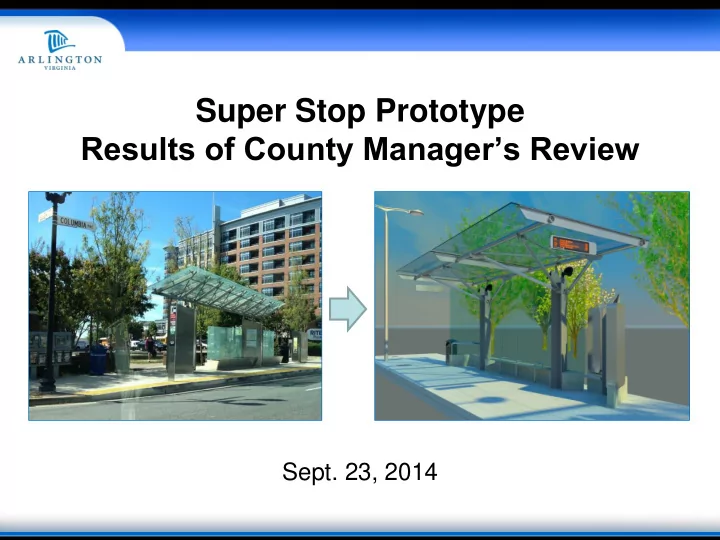

Super Stop Prototype Results of County Manager’s Review Sept. 23, 2014
Performance and Financial Review CliftonLarsonAllen LLP conducted the review • Selected through a competitive process • Work completed at the direction of the Department of Management and Finance • Scope of work – Performance review on the project development and delivery – Financial review of costs associated with the project 2
Performance and Financial Review Performance review findings • Lack of clear communication between County and WMATA staff • Unforeseen external delays, specifically VDOT approval • Poor execution of construction performance Financial review findings • Documentation provided to WMATA from Potomac Construction lacked proper detail to support additional payments from the County • Change orders were not agreed to in writing per the Agreement, resulting in those costs being borne solely by WMATA • Original budget of $2,150,000 for three prototypes was not amended when scope changed from three prototypes to one 3
Performance and Financial Review Prototype costs Amount Construction costs supported by County funds $1,020,211 County project management costs $319,604 Total costs $1,338,815 Walter Reed prototype = $881,933 Fabrication of parts for two other prototypes = $456,882 4
Performance and Financial Review CliftonLarsonAllen recommended that the County take several steps : • Develop a formal process to establish criteria for escalating difficulties with contractors, partners or other third parties to the next level. • Consider revising agreements with partners to include consequences for failure to achieve project benchmarks. • Ensure the County has outlined all project tasks and the expected timeline prior to the project starting, especially when working with third parties. • Ensure an individual is assigned to monitor the budget throughout a project. • Ensure agreement language clearly identifies roles and responsibilities of all parties involved. For future Columbia Pike transit stations, the County will : • Directly oversee construction – All consultants and contractors will work directly for the County. • Control costs throughout design and construction – This includes identifying risks early in project development, and enhanced monitoring and management of costs. 5
Columbia Pike Transit Stations We heard the community We developed a better design We substantially reduced costs We will take over management of the project from WMATA and deliver it effectively and efficiently We will continue to leverage federal and state funding 6
Vision for the Pike • Create an improved, walkable “Main Street” • Neighborhoods linked by enhanced transit and a street that balances all modes of travel (complete street) Transform the corridor from an Vibrant, pedestrian-friendly, “aging auto -oriented, suburban, into a “Main Street” destination commercial strip”
Serving More Transit Riders Nearly all transit station locations along Columbia Pike have more than 100 daily boardings – with ridership expected to more than double by 2035. Transit station adds: Basic stop includes: Sheltered stop adds: • Larger shelter, seating • Sign • Small shelter, seating • Raised platform (near-level boarding) • Information/schedule • Bus bay or curb • Real-time information display • Paved boarding area extension • Lighting • Off-board fare payment Typical ridership: Typical ridership: <40 boardings daily 40-100+ boardings daily Typical ridership: 250-1000+ boardings daily 8
Results of Design Review What we improved: Better canopy coverage (larger and lower with reduced angle) ‒ Doubled covered standing capacity for standard size station Better pedestrian circulation Improved ADA accessibility Better seating ‒ Increased amount of covered seating “Kit of parts” design (modular) What we kept: Passenger amenities Real-time information Lighting Design aesthetics 9
How We Cut Costs Simplified the design – Modular, flexible – can be scaled Cheaper to up or down build – Standardized components – Less structure, less steel Cheaper to – Eliminated ice melt system maintain – Scaled program to ridership 10
Construction Cost Breakdown Estimated Construction Cost (Standard size): $361,000 Structure: $192,000 Supporting infrastructure: $169,000 Structure includes : Supporting infrastructure includes : • • Station platform - 10” -high curb, 90-feet long Steel beams, bracing and columns • Glass roof panels to accommodate two transit vehicles • • Glass windscreens Foundations and footings • • Benches and lean bars Power • • Display cases and electronic real- Site preparation • time transit information display Landscaping/site restoration 11
Transit Stations in Other Cities Eugene, Oregon – BRT Alexandria, VA – BRT Charlotte, NC – LRT Grand Rapids, MI – BRT 12
Program Funding 2013 CIP = $20.9 million 2015 CIP = $12.4 million (24 stations) (23 stations) Local - G.O. Bond = 5% Program cost reduced 40 percent $1 million Local - G.O. Bond = 6% $800,000 Federal = 38% Local - TCF= 33% $8 million $6.8 million Local - TCF= 28% Federal = 52% $3.5 million $6.4 million State = 24% $5.1 million State = 14% $1.7 million Note: Local - TCF is commercial real estate tax revenues that can 13 only be spent for new transportation projects.
Summary We have: Cut standard-size station cost significantly Reduced program costs by 40% Developed a better design that shelters more people Taken over project management Incorporated lessons learned Stayed true to the goal of providing great transit for the Pike 14
Moving Forward • Begin design this fall for new station sizes and next eight stations ‒ Consulting the community: We will seek targeted input on specific elements of the updated design • Plan to build remaining 23 stations in phases ‒ Construction of the next eight stations expected to begin in late 2015/early 2016 Project information: http://projects.arlingtonva.us/projects/columbia-pike-transit-stations/ 15
Recommend
More recommend